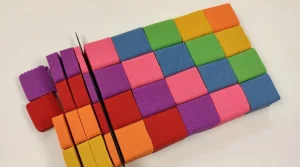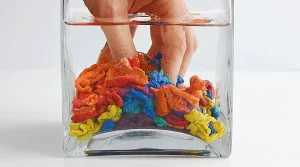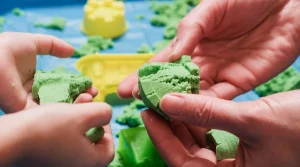
What Is Sensory Sand Made Of? The Science and Benefits
Explore what sensory sand is made of, why children love it, and how its unique materials enhance learning, creativity, and fine motor skills.
#1 Toys Manufacturer in China. WhatsApp: +86 180-0088-4063. Email: [email protected]
#1 Toys Manufacturer in China. WhatsApp: +86 180-0088-4063. Email: [email protected]

Kinetic sand has taken the toy world by storm, becoming a favorite among children and adults alike. It offers a unique, tactile experience that encourages creativity and sensory play. However, one common concern parents and caregivers often have is whether this toy is messy. The idea of sand spreading everywhere can be daunting, especially in a household where tidiness is important.
In this blog, we’ll explore the truth behind the messiness myth surrounding kinetic sand.
Kinetic sand is a popular sensory toy made from a unique combination of natural sand and silicone oil.
The key to kinetic sand’s behavior lies in the interaction between the sand particles and silicone oil. When you touch the sand, the oil creates a frictionless surface, allowing the grains of sand to move and stick together.
This interaction allows the sand to flow like a liquid while still maintaining its solid form. It’s an example of what scientists call a non-Newtonian fluid. When pressure is applied, the sand can be molded. But when left undisturbed, it behaves like a loose pile of grains.
The silicone oil also plays a role in reducing the mess. It prevents the sand from scattering, making it much easier to clean up compared to traditional sand.
When it comes to kinetic sand, the idea of messiness is often a concern. However, it’s not as messy as many might think. Unlike regular sand, kinetic sand has a unique set of properties that prevent it from scattering and making a mess.
Kinetic sand’s behavior is due to its special composition. The sand grains are coated with a thin layer of silicone oil, which gives the sand a smooth, sticky quality. This prevents the sand from flying everywhere when touched or moved.
When you handle kinetic sand, the particles cling together, rather than scattering like traditional sand. It’s this ability to stick together that reduces the messiness, making cleanup easier.
Unlike the sand at the beach, which easily sticks to clothing and is difficult to remove, kinetic sand behaves differently.
Because of the silicone oil, it doesn’t adhere to surfaces as much, and when it’s dropped, it stays clumped together. Cleaning up kinetic sand is as simple as gathering it back into a pile and smoothing it out—there’s no fine dust or small grains to worry about.
Unlike traditional sand, which tends to spread across the floor or stick to skin and fabrics, kinetic sand is more controlled, making it far easier to manage and clean up.
Kinetic sand is a unique toy that feels like a strange cross between sand and playdough. But what makes it behave so differently from regular sand? It all comes down to the ingredients and the science behind it.
One of the key ingredients in kinetic sand is silicone oil. This is the secret to why kinetic sand sticks together and behaves so differently.
Silicone oil coats each grain of sand, making them smooth and slightly sticky. When you play with it, the sand particles cling to each other, preventing them from scattering everywhere. This also contributes to the “flowing” effect of kinetic sand, where it moves in clumps rather than breaking apart.
Without the silicone oil, kinetic sand would behave like regular sand, making a mess that’s difficult to clean.
At first glance, kinetic sand might look just like regular sand. However, their behaviors are very different in practice.
| Aspect | Kinetic Sand | Regular Sand |
|---|---|---|
| Ingredients | Sand mixed with silicone oil | Pure sand |
| Behavior | Sticks together, flows smoothly, and holds shapes | Loose, dry, and scattered easily |
| Messiness | Low mess, easy to clean up | Can scatter easily, harder to clean |
| Playability | Molds well, retains form | Difficult to mold, breaks apart easily |
| Cleaning | Quick to clean, doesn't stick to surfaces easily | Sticks to clothes and surfaces, harder to clean |
In short, the key difference between kinetic sand and regular sand lies in the silicone oil, which prevents the sand from scattering, making cleanup easier and play more fun. This scientific twist is what gives kinetic sand its unique characteristics.
Both kinetic sand and magic sand have gained popularity, but there are key differences that make each one unique. While they may seem similar at first glance, their properties and behavior in play are distinct.
>> Is Magic Sand the Same as Kinetic Sand? Unpack the Differences
| Aspect | Kinetic Sand | Magic Sand |
|---|---|---|
| Water-Repelling Properties | Does not repel water; remains malleable and easy to shape | Repels water; forms clumps when submerged in water |
| Cleanliness | Easy to clean; sticks to itself, not to surfaces or hands | Can be harder to clean; clumps can be tricky to remove |
| Play Behavior | Smooth, cohesive, and flows easily; sticks to itself but not to hands or surfaces | Forms clumps when wet, can be molded but behaves less smoothly |
| Surface Interaction | Doesn't leave residue or stick to most surfaces | Can be more difficult to remove from surfaces when dry |
| Versatility in Play | Ideal for molding and creative play without a mess | Fun for experiments but less versatile for regular play due to its water-repellent feature |
| Ease of Clean-up | Simple and quick clean-up; just sweep or vacuum | Clean-up can be more challenging, especially if wet or clumped |
When it comes to cleaning kinetic sand, many people worry about the mess it might create. However, unlike traditional sand, cleaning up kinetic sand is relatively easy. Its unique properties make it less messy and simpler to manage, making it a popular choice for both kids and adults.
Kinetic sand is designed to stick to itself rather than to surfaces or hands, which makes it much easier to clean up. Here’s how you can quickly clean it up:
Although kinetic sand is much easier to clean than regular sand, there are ways to minimize the mess during play, ensuring the clean-up is even simpler:
By using these simple cleaning methods and tips for minimizing mess, you can keep your play area neat and your kinetic sand experience stress-free.
Storing kinetic sand properly ensures it stays in great condition, preventing it from drying out or becoming a mess. Whether you’re a parent or a collector, these tips will help keep your kinetic sand organized and ready for play.
One of the best ways to store kinetic sand is in airtight containers. This method is crucial for several reasons:
To store your kinetic sand in an airtight container, make sure the lid fits snugly and there are no gaps. You can use any type of container, such as plastic bins or jars, as long as they provide a secure seal.
To keep kinetic sand neat and organized, especially if you have multiple colors or sets, using separate storage bins is a great idea. Here’s how you can do it:
By storing your kinetic sand in airtight containers and organizing it in separate bins, you can keep your sand in excellent condition and make playtime even more enjoyable. These simple storage methods will help you preserve the sand’s texture while keeping it easy to access whenever you’re ready to play.
Kinetic sand is a versatile and fun toy that appeals to people of all ages. Whether you’re a young child exploring new textures or an adult looking to relieve stress, kinetic sand can be enjoyed by everyone.
>> Kinetic Sand Cutting: How Does ASMR Work
Kinetic sand is typically safe for children as young as 3 years old. However, age recommendations can vary depending on the complexity of the play sets or accessories involved.
Kinetic sand is perfect for toddlers. Its soft, moldable texture is ideal for young hands, and its smoothness makes it easy to shape and squish. Toddlers can use kinetic sand for basic activities like molding simple shapes or learning how to use basic tools like spoons or small molds.
Older children can benefit from more intricate play with kinetic sand. They can use it to create more complex structures, like castles or landscapes, or even simulate activities like digging or sculpting. This age group also enjoys using kinetic sand as part of themed play sets, such as creating miniature towns or playgrounds.
While kinetic sand is marketed mostly for younger audiences, it can also be a relaxing, stress-relieving tool for adults. Its calming properties can be beneficial for individuals looking to unwind after a long day. Teens may also find it enjoyable for creative and artistic expression, designing detailed sculptures or experimenting with different textures.
Kinetic sand is more than just a fun toy; it also provides significant educational and sensory benefits, particularly for young children. Here’s how it helps with development:
Kinetic sand provides a unique tactile experience. Children can feel its smooth texture, which stimulates sensory receptors in the skin. This hands-on experience helps them develop fine motor skills and hand-eye coordination. The sensory feedback from manipulating kinetic sand also enhances their understanding of how different textures can feel and change.
Playing with kinetic sand encourages creativity and problem-solving. Kids can learn cause-and-effect relationships as they press, shape, and manipulate the sand. As they work with the sand, they also practice spatial awareness and planning, as they need to visualize and execute their designs.
For younger children, kinetic sand helps foster concentration and patience. The act of shaping and molding the sand can be calming, which is helpful for emotional regulation. As kids explore new ways to shape and create, they gain a sense of accomplishment, which boosts their confidence.
In short, kinetic sand is a wonderful tool for children’s development. It offers not only a fun and engaging experience but also valuable learning opportunities, all while being accessible to different age groups.
Kinetic sand offers a unique play experience that is fun, engaging, and surprisingly clean. Unlike regular sand, it sticks to itself and not to other surfaces, which means less mess for parents and more fun for kids.
Kinetic sand is not only an enjoyable activity but also a valuable tool for fine motor skill development, creativity, and focus.
Kinetic sand is versatile and can be enjoyed in a variety of settings, both indoors and outdoors.
| Setting | Indoor Play | Outdoor Play |
|---|---|---|
| Best Locations | Living room, kitchen, playroom, or any indoor space. | Backyard, park, or any outdoor space. |
| Weather | Ideal for cold or rainy days. | Great for sunny or warm days. |
| Setup | Requires a tray or mat to avoid making a mess. | Can be set up in a large outdoor area, easy to clean up. |
| Mess Management | Minimal mess when played on a tray or mat. | Less mess than traditional sand, but outdoor wind may carry it away. |
| Use Cases | Educational activities, creative play, sensory exploration. | Large-scale play, group activities, or experimenting with nature elements. |
Kinetic sand is adaptable and can be enjoyed in various environments, from your home to educational and therapeutic settings. Its versatility makes it a great choice for both fun and learning.
In Classrooms
For Therapy and Focus Activities
Kinetic sand is often misunderstood, with myths about its messiness and safety lingering in conversations. Let’s address these common misconceptions and present the truth behind the fun.
Many people believe that kinetic sand is too messy to handle. They picture sand spilling everywhere, creating a chaotic cleanup process. However, that’s simply not the case.
Kinetic sand is designed to stick together, so it doesn’t scatter like traditional sand. When playing with kinetic sand, it stays compact, reducing the risk of spills. Even if a little bit does escape the play area, it’s easily cleaned up using simple methods like a vacuum or a damp cloth.
The misconception that it makes a huge mess is largely due to comparing it with regular sand, which behaves much differently.
In reality, kinetic sand is a safe, non-toxic material made for children’s play. Unlike some other play materials, it doesn’t contain harmful chemicals, making it suitable for younger children.
The sand is also easy to clean, as it doesn’t dry out or crumble easily, unlike traditional play sand. It sticks to itself, which means it stays in your play area rather than scattering all over the room.
Plus, it has a pleasant texture, allowing kids to engage in creative play without the mess. Safety and ease of use are some of the key benefits that make kinetic sand a popular choice for sensory and creative activities.
Kinetic sand is far from the messy, troublesome material some believe it to be. Its unique properties make it safe, clean, and fun for all ages, whether at home, in classrooms, or therapy sessions. By debunking myths, we can appreciate this creative toy for what it truly is—a mess-free way to spark imagination!
No, kinetic sand doesn’t stain surfaces. Its unique texture allows it to stick to itself rather than other materials. If some particles stick to furniture or floors, they can be easily picked up with more sand or wiped away with a damp cloth.
Kinetic sand doesn’t create dust or crumbs when used as intended. It’s moist and clumpy, unlike dry sand. However, using it on rough or porous surfaces may cause tiny pieces to stick. A smooth play mat helps keep everything contained.
Kinetic sand can handle a small amount of water, but it may lose its flowing texture. To fix it, spread it out to dry at room temperature. Avoid soaking it completely, as excess moisture can affect its ability to stick together.
While toddlers might spread kinetic sand around, it’s not inherently messy. Its self-sticking quality makes cleanup easier than traditional sand. Supervision and setting up a contained play area, like a tray or mat, can minimize mess.
Kinetic sand rarely embeds deeply into fabrics due to its clumping nature. If it lands on a carpet, press more sand onto the area to lift it off. A vacuum cleaner can pick up any leftover bits without damaging the fibers.
More Related...

Explore what sensory sand is made of, why children love it, and how its unique materials enhance learning, creativity, and fine motor skills.

Discover what makes kinetic sand so special — from its unique texture to the fascinating science behind its magical movement.

Is magic sand safe for kids? Explore safety facts, age guidelines, and expert advice to ensure fun, creative, and secure sensory play.

Kinetic sand toys offer fun and education in one—find out how they support child development, relaxation, and imaginative play.

Our team will answer your inquiries within 48 hours.
Copyright © 2025 GuangDong AKIA Technology Co,. Ltd. All Rights Reserved